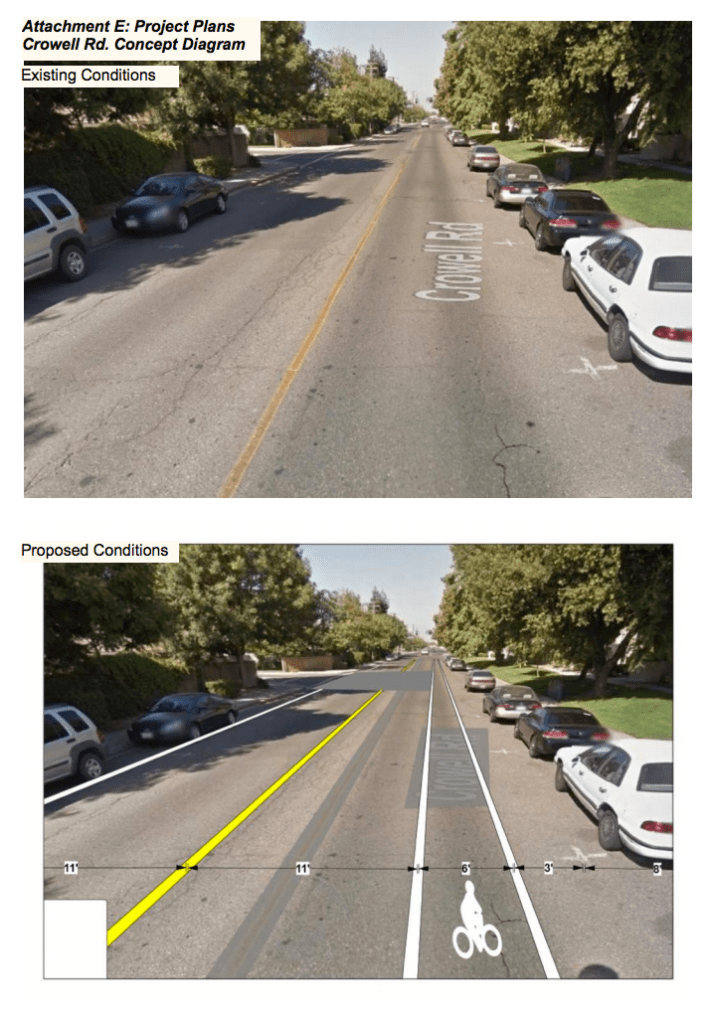
Walking and bicycling in Turlock will become much safer now that the city was awarded more than a million dollars from the state Active Transportation Program (ATP) to improve bicycle and pedestrian infrastructure.
“I think they are good projects that are good for the community,” Nathan Bray, Principal Civil Engineer, said of the two projects that were approved for funding by the California Transportation Commission.
The two projects will connect walking and biking routes and improve safety near schools in Turlock.
One of projects will improve pedestrian safety near Cunningham Elementary School, where more than 90 percent of the student body is from low-income families.
The grant will allow the city to widen a large portion of West Linwood Avenue (between Lander Avenue and West Avenue South), and to install curb gutter, sidewalks, and a bicycle lane along the north edge of the street. The city will also be able to construct a continuous left-turn lane that will improve traffic flow near the school. For copies of the full renderings, click here and here.
“Right in front of the school, westbound movement backs up during peak hours, so that people back up on roads,” Bray said. “You have children crossing [there]; it’s not an ideal situation.”
Cunningham Elementary will also be the location of Turlock's first pedestrian-activated hybrid beacon.
Elizabeth Claes, a bicycling advocate in Turlock, helped gather support for the project, speaking at board meetings and collecting signatures of supporters. She sees the upgrades as a social justice issue, since it will benefit the mostly low-income families that send their children there.
“[The school] doesn’t have bicycle lanes, it doesn’t have sidewalks, it doesn’t have turn lanes,” she said of current conditions. “It has mud.”
“Will this improve their lives?” Claes asked. “Yes.”
A second project that received ATP funding will improve things for bicyclists along Christoffersen Parkway, a main thoroughfare that passes by five schools including California State University's Stanislaus campus. The city plans to install buffered bicycle lanes, green pavement enhancements at intersections, and a connector to Tegner Road, which is currently blocked off at Christoffersen. Also, intersection improvements between Crowell and Ansel Adams Boulevard will provide easier and safer entrance to the CSU campus for cyclists.

The total cost of the two projects is estimated at $1.5 million, with a majority of those costs, a little over $1 million, provided by the ATP. City staff said they plan to pursue other funding to cover the remaining costs, and that construction should begin in 2018.
Wayne York, Transportation Engineering Supervisor, said he received notice that the city's ATP applications were approved when the city council was approving its own Active Transportation Plan. Turlock has had small pots of funds to improve non-motorized transportation, and has incorporated active transportation elements when appropriate in other projects, but tight budgets have been a barrier to larger projects, so the funding is welcome.
Turlock was the only city in Stanislaus County that was awarded ATP funding from the statewide competitive program, and Bray attributes the successful grant application to the public’s support for plans.
“I think that was the key: the level of comment we had on the project,” he said.
Claes says she is glad to see that the community is being asked to participate in project planning and that in turn the public is giving input. She and her family began bicycling as their primary mode of transportation five years ago, at a time when there was no conversation on ways to improve roads for cyclists, she said.
“I would see road improvements and think, ‘Oh, they're fixing it!’ And sometimes it would get better and other times it would get worse,” she said.
Claes, who started a bicycling advocacy group called the Bike Turlock Project, said she took up bicycling safety and infrastructure as a cause to counteract what she sees happening in government, where “people complain, and [then they] disappear,” she said.
Turlock, in the middle of California's Central Valley, is not exactly known as a “bike town.” It has wide roads and lacks bicycle-specific infrastructure. “It’s more people who want to do it than those who need to,” Bray said, adding that from his observations the majority of bicyclists bike for pleasure as opposed to mode of transportation
Claes, whose mode main mode of transportation is a bicycle, disagrees with the notion that most cyclists in Turlock bike for pleasure rather than transportation. But she understands why Bray has only encountered one kind of “aspirational bicyclists,” as she calls them.
Despite the city’s best efforts to get diverse opinions during the ATP planning period, Claes said that many of the people who attended the workshops and meetings have multiple transportation options, and they know how to navigate government and the political system.
“Theirs was the loudest voice in the conversation because they tended to be educated, white, and have English as their first language,” she said.
But they were not the people she meets and talks with about the true reality of bicycling in Turlock, she said. “These are the people who bicycle in the rain and the fog and at night, who become so much a part of the landscape of our streets that they stop being seen,” she said.
To truly make Turlock a “bike town,” City Hall would have to step out of its comfort zone and travel to the places where these bicyclists can be found, she said.
Whatever the reason people don’t bicycle, Bray said the city tries to provide as many opportunities as possible for bicycle users on Turlock’s transportation network.
Claes agrees that Turlock is slowly catching up. “I celebrate the red curbs that have been painted, the stop signs that have been put in. I’m hopeful for the future,” she said.





